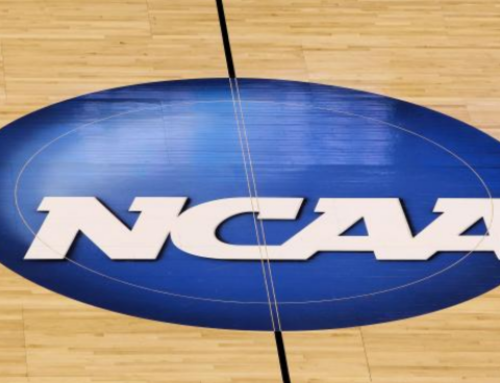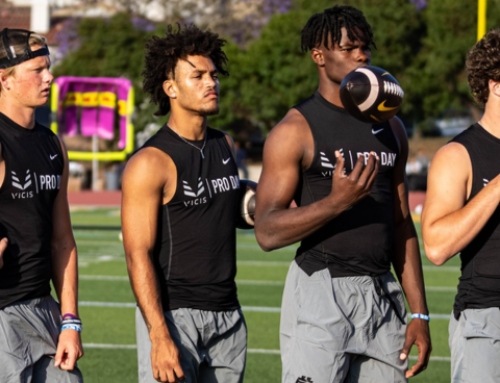This NCAA Scholarship Rules Change Could Make A Lot of Student-Athletes Ineligible
Student-athletes and their parents dream of the day when they finally sign that coveted athletic scholarship.
Beginning in 2016, several NCAA scholarship rules are set to change. Although many students and parents are unaware of the changes, their effects could be profound, including an adjustment to the minimum GPA requirement, which could leave incoming freshmen ineligible to receive athletic scholarship money.
RELATED: Visit STACK’s Complete College Recruiting Center
The GPA rule would increase the minimum requirement from a 2.0 to a 2.3 average in core academic classes. While three-tenths of a point may not seem like a big leap, the NCAA estimates that 35.2 percent of college football players who suited up during the 2009-10 season would not have been eligible if the 2016 requirements had been in place then. The same report indicated that 43.1 percent of men’s basketball players would not have been ineligible.
Making matters more complicated, the 2.3 GPA figure is not that clearcut. The figure applies to “core” classes only, and the number and names of core classes vary from school to school.
What is a “core class”?
It depends on what school you attend. Each high school submits potential “core classes” to the NCAA for review. Some schools have 50 to 100 approved core classes, giving students ample opportunities to choose and score well, and to meet the new requirements. Other schools may only have 20 approved core classes. Students at such schools have fewer choices, but they still must maintain a 2.3 GPA in 16 of the 20 classes. This can dramatically affect students who struggle in a particular area, since they have fewer options for meeting the core class requirement.
As a consultant who helps college-bound student-athletes, I’ve seen the effects of core class confusion firsthand. One student I’ve been working with, Gary, is a highly rated high school athlete drawing interest from Division I schools. Carrying a 2.34 cumulative GPA, he felt confident he was on track to start receiving scholarship offers. But when we dug into the numbers, we found his core class GPA was only 2.13. He is effectively ineligible not only for scholarships but also to participate in sports during his freshman year.
RELATED: Understanding “Grayshirting”
How did this happen? Gary did well in non-core classes like Woodshop, Intro to Drums, and Math Apps, but he scored a D- in Algebra 1 and an F in Spanish.
Like Gary, most students assume that Math Apps is a core class, but it isn’t. Meanwhile, Algebra and Spanish are considered core classes in his high school.
What’s frustrating about the core class process is that a student can be penalized by his school’s offerings. For Gary, Algebra 1 proved too difficult, while math apps was easy but didn’t count. A similar school in a nearby district has a wider variety of math options, including an Integrated Math course, which tends to be less difficult, yet is approved by the NCAA. But Gary didn’t have access to that course.
Another element of the rule worth noting is that students need to complete 10 of 16 core courses before beginning their senior year of high school. To determine what classes the NCAA considers approved core courses, check your school’s listing.
Why you should ACT now
The NCAA weighs a student’s ACT or SAT scores when considering eligibility, making the tests a potential failsafe for students hovering around the minimum GPA requirement—or another way to lose scholarship dollars. The tests are placed on a sliding score in relation to eligibility: the higher the GPA, the lower the ACT/SAT requirement.
A student who holds a 2.3 GPA is still ineligible if he does not also score at least a 75 cumulative on the ACT. (Scoring a 19 out of a potential 36 in each of the four test areas would give a student a 76 cumulative total.) Students complete at least 10 of their 16 core courses before beginning their senior year, and who have a GPA below 2.3 but above 2.0, may be eligible to redshirt if their ACT/SAT meets the new scale.
Gary’s GPA means he needs to score at least 82 on the ACT, but currently he’s five points shy of that. If he’s unable to improve his test score or his GPA, he’ll be ineligible even to redshirt. And it’s not because he didn’t try or work hard—it’s because he didn’t understand the requirements and how they are changing.
The NCAA made these rule changes to better ensure academic preparedness, not to limit eligibility. That goal is admirable. Student-athletes should be prepared to handle college-level courses, and to have the ability to be successful academically as well as athletically. Unfortunately, many variables are at work, and not all are fully clear to many students.
How to stay eligible
What can you do to make sure you’re eligible for scholarship dollars? First and foremost, plan early. When mapping out your high school classes, determine which classes will count toward your core course requirement. If you are struggling in a subject, seek help through tutoring.
RELATED: Guess What? Colleges Are Definitely Watching What You Post on Social Media
Take the ACT early and often. You can take the test as many times as you like throughout your senior year, but if you wait, you’ll eventually run out of opportunities to increase your score. Test prep can help you earn more points on the exam.
Above all, look into your eligibility early and often. The sooner you check it, the better your chances of being offered the scholarship opportunity you seek.
[cf]skyword_tracking_tag[/cf]RECOMMENDED FOR YOU
MOST POPULAR
This NCAA Scholarship Rules Change Could Make A Lot of Student-Athletes Ineligible
Student-athletes and their parents dream of the day when they finally sign that coveted athletic scholarship.
Beginning in 2016, several NCAA scholarship rules are set to change. Although many students and parents are unaware of the changes, their effects could be profound, including an adjustment to the minimum GPA requirement, which could leave incoming freshmen ineligible to receive athletic scholarship money.
RELATED: Visit STACK’s Complete College Recruiting Center
The GPA rule would increase the minimum requirement from a 2.0 to a 2.3 average in core academic classes. While three-tenths of a point may not seem like a big leap, the NCAA estimates that 35.2 percent of college football players who suited up during the 2009-10 season would not have been eligible if the 2016 requirements had been in place then. The same report indicated that 43.1 percent of men’s basketball players would not have been ineligible.
Making matters more complicated, the 2.3 GPA figure is not that clearcut. The figure applies to “core” classes only, and the number and names of core classes vary from school to school.
What is a “core class”?
It depends on what school you attend. Each high school submits potential “core classes” to the NCAA for review. Some schools have 50 to 100 approved core classes, giving students ample opportunities to choose and score well, and to meet the new requirements. Other schools may only have 20 approved core classes. Students at such schools have fewer choices, but they still must maintain a 2.3 GPA in 16 of the 20 classes. This can dramatically affect students who struggle in a particular area, since they have fewer options for meeting the core class requirement.
As a consultant who helps college-bound student-athletes, I’ve seen the effects of core class confusion firsthand. One student I’ve been working with, Gary, is a highly rated high school athlete drawing interest from Division I schools. Carrying a 2.34 cumulative GPA, he felt confident he was on track to start receiving scholarship offers. But when we dug into the numbers, we found his core class GPA was only 2.13. He is effectively ineligible not only for scholarships but also to participate in sports during his freshman year.
RELATED: Understanding “Grayshirting”
How did this happen? Gary did well in non-core classes like Woodshop, Intro to Drums, and Math Apps, but he scored a D- in Algebra 1 and an F in Spanish.
Like Gary, most students assume that Math Apps is a core class, but it isn’t. Meanwhile, Algebra and Spanish are considered core classes in his high school.
What’s frustrating about the core class process is that a student can be penalized by his school’s offerings. For Gary, Algebra 1 proved too difficult, while math apps was easy but didn’t count. A similar school in a nearby district has a wider variety of math options, including an Integrated Math course, which tends to be less difficult, yet is approved by the NCAA. But Gary didn’t have access to that course.
Another element of the rule worth noting is that students need to complete 10 of 16 core courses before beginning their senior year of high school. To determine what classes the NCAA considers approved core courses, check your school’s listing.
Why you should ACT now
The NCAA weighs a student’s ACT or SAT scores when considering eligibility, making the tests a potential failsafe for students hovering around the minimum GPA requirement—or another way to lose scholarship dollars. The tests are placed on a sliding score in relation to eligibility: the higher the GPA, the lower the ACT/SAT requirement.
A student who holds a 2.3 GPA is still ineligible if he does not also score at least a 75 cumulative on the ACT. (Scoring a 19 out of a potential 36 in each of the four test areas would give a student a 76 cumulative total.) Students complete at least 10 of their 16 core courses before beginning their senior year, and who have a GPA below 2.3 but above 2.0, may be eligible to redshirt if their ACT/SAT meets the new scale.
Gary’s GPA means he needs to score at least 82 on the ACT, but currently he’s five points shy of that. If he’s unable to improve his test score or his GPA, he’ll be ineligible even to redshirt. And it’s not because he didn’t try or work hard—it’s because he didn’t understand the requirements and how they are changing.
The NCAA made these rule changes to better ensure academic preparedness, not to limit eligibility. That goal is admirable. Student-athletes should be prepared to handle college-level courses, and to have the ability to be successful academically as well as athletically. Unfortunately, many variables are at work, and not all are fully clear to many students.
How to stay eligible
What can you do to make sure you’re eligible for scholarship dollars? First and foremost, plan early. When mapping out your high school classes, determine which classes will count toward your core course requirement. If you are struggling in a subject, seek help through tutoring.
RELATED: Guess What? Colleges Are Definitely Watching What You Post on Social Media
Take the ACT early and often. You can take the test as many times as you like throughout your senior year, but if you wait, you’ll eventually run out of opportunities to increase your score. Test prep can help you earn more points on the exam.
Above all, look into your eligibility early and often. The sooner you check it, the better your chances of being offered the scholarship opportunity you seek.
[cf]skyword_tracking_tag[/cf]RECOMMENDED FOR YOU
Create A Free Recruiting Profile Today!
CaptainU helps athletes & parents not only be proactive but also to manage and take control of their entire recruiting journey.











